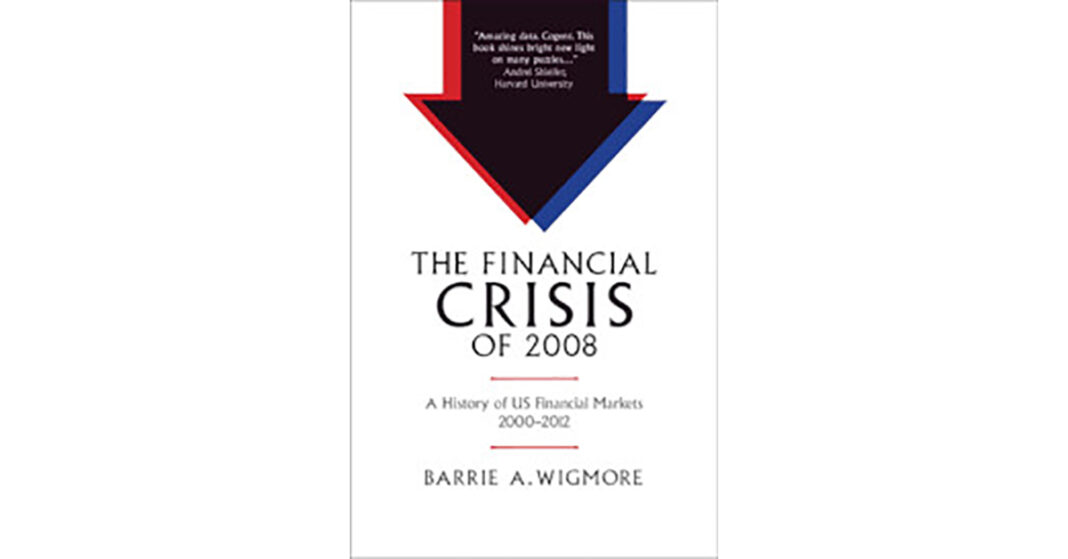The Financial Crisis of 2008: A History of US Financial Markets 2000–2012. 2021. Barrie A. Wigmore. Cambridge University Press.
Barrie Wigmore analyzes an extremely complex topic, the financial crisis of 2008, with wide-ranging and deep analysis. He brings to bear a richly experienced point of view, based on working “in the trenches” as an investment banker over multiple cycles.
For Wigmore, shocking levels of leverage sounded the main alarm about the mounting crisis. This was represented most dramatically by the Federal National Mortgage Association (Fannie Mae) and the Federal Home Loan Mortgage Corporation (Freddie Mac) operating with leverage of 100 to 1. These government-sponsored enterprises had to make subprime loans and hold private residential mortgage-backed securities (RMBSs) because the US Department of Housing and Urban Development (HUD) had mandated that these institutions increase the number of low-income homeowners, beginning with the Community Reinvestment Act in 1992.
In November 2004, HUD set additional low-income lending goals for Fannie Mae and Freddie Mac. Fannie Mae exceeded these aggressive goals in 2005 and again in 2006. At this point in the narrative, the author tells the story in such an exciting way that you can smell the credit danger lurking around the corner. Not only do subprime borrowers represent a disturbingly high percentage of total borrowers, but also Wigmore presents astonishing data directly out of Fannie Mae’s “credit book” cited in its 2006 10-K. The data suggested that both Fannie Mae and Freddie Mac were exposed, beyond HUD’s mandates, to the weakest credit sectors.
While this was occurring, state and local government pension funds, insurance companies, and the commercial and investment banking intermediaries that serviced Fannie Mae and Freddie Mac continued to fund them despite their unlimited information resources, their attention to financial markets, and their own stakes in the outcome. There was also the parallel challenge of seeking higher investment returns in a declining interest rate environment — not only for retail investors but also for institutional investors, the so-called smart money. This stretch for yield is presented in Table 2.5, which sums up in simple terms the $11 trillion apocalypse to come.
Wigmore cogently presents the setting for the crisis. It visibly began in the second half of 2007, with house prices leveling off after huge runs in such places as Los Angeles, Phoenix, and Las Vegas. The US Federal Reserve noted that consumers’ debt servicing capability was deteriorating from traditional levels, even with the low interest rates prevailing at the time. Consumer liabilities rose from 15% to 22% of net worth between 2000 and 2007, due in particular to growth in residential mortgage debt. Yet, the Fed evidenced no major concern at that time, believing that consumer strength would support a further rise in consumer spending.
Subprime mortgages were beginning to default at high rates. The value of asset-backed securities and private RMBSs sank. Mortgage originators with large sub-prime exposure, such as New Century and Fremont General, lost their lenders. Countrywide Financial, IndyMac, and Washington Mutual faced unprecedented disruptions. Their published balance sheets did not keep up with the rapid deterioration in the quality of their loans.
The institutional collapses that occurred had a common narrative: extreme leverage; complicated, if not unexplainable, real-time balance sheets; and poor-quality assets, in the case of investors, or liabilities, in the case of lenders. The author methodically explains the collapses, with numerous graphs to underscore the severity of the strains, both individually and systemwide.
In the chapter titled “Epilogue 2012–2016,” Wigmore cites many instructive indicators of market and economic recovery. Security markets’ recovery preceded recovery in the economy, based on anticipated recovery in S&P 500 Index earnings forecasts. In 2012, equity valuations stretched in a way never before seen, as the S&P 500’s dividend yield and the 10-year Treasury rate converged for the first time since 1957. Housing prices and commercial real estate sales rebounded. Consumer confidence rose. Federal debt to GDP was still high; however, the Fed’s balance sheet was huge, interest rates were artificially low, and the status of Fannie Mae and Freddie Mac remained to be determined.
In reading this masterful book, I was initially impressed by its structure in addressing such a complex time in history. It analyzes the market and economic environment preceding the crisis, during the crisis, and over a number of years that followed it. The book delves deeply into the institutions and the securities. The author differentiates opinion from fact, relying on extrapolation from actual reported numbers. I found it impressive that he uses the analyst’s most trusted original sources, corporate 10-Ks and 10-Qs. Neatly rendered graphics and tables assist the analytical narrative. Wigmore cites Federal Reserve Economic Data (FRED) frequently and appropriately.
The Financial Crisis of 2008 is essential reading for banking, investment, and insurance firm leadership but also for investors, analysts, economists, and students of financial and investment history. It depicts how widespread risk-taking at the firm level can morph into systemwide near collapse and how the mantra of homeownership for all must be considered in light of the associated financial risks and undisciplined creation of asset-backed securities. The book is required reading for a generation.
If you liked this post, don’t forget to subscribe to the Enterprising Investor.
All posts are the opinion of the author. As such, they should not be construed as investment advice, nor do the opinions expressed necessarily reflect the views of CFA Institute or the author’s employer.
Professional Learning for CFA Institute Members
CFA Institute members are empowered to self-determine and self-report professional learning (PL) credits earned, including content on Enterprising Investor. Members can record credits easily using their online PL tracker.



